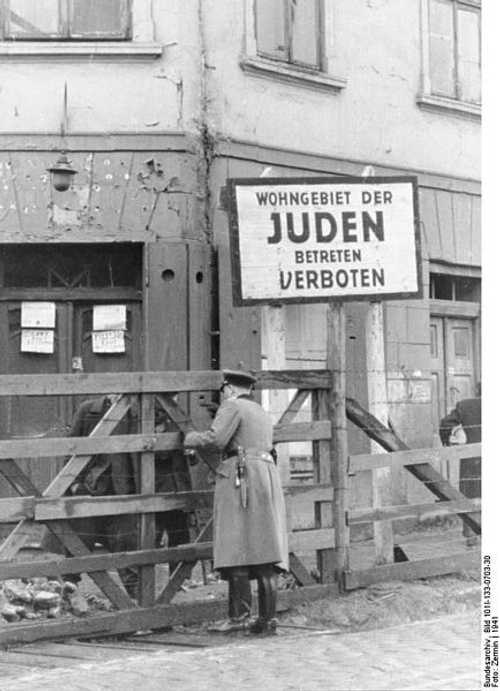
German Forces
Abandon Hope all ye who enter here ...
Bundesarchiv.
German policeman (note the bayonet) acts as a "gatekeeper" (Bundesarchiv caption) at the Litzmannstadt (Lodz) ghetto, Poland, 1941. The sign may be translated as "Jewish residential area - entry forbidden". The Lodz ghetto, second largest Jewish ghetto in Poland, is a slightly unusual case among ghettos. Its initiation involved the relocation of the very large Jewish population of Lotz from across the city into a designated district, a process achieved with the aid of homicidal intimidation. Further inmates arrived due to the depopulation of Jews from the general area and beyond, and continued over time. "Overflows" were dealt with by transporting the surplus to the Chelmno proto-death camp and, possibly, to Aktion Reinhart camps. When the Ghetto was eventually liquidated, the remaining Jews were transported to Chelmno and Auschwitz for "processing". The latter event did not occur until well into 1944, with the Soviets almost knocking at the door. Why, when every other ghetto in Poland had been liquidated by late-1943 ? Well, it appears to be because the particular circumstances of the Lodz Ghetto allowed it to be organized as a particularly productive industrial centre, producing goods (mainly clothing) for the Wehrmacht at low cost. One reason for this was unusual degree of isolation suffered by the ghetto inmates. Black market activities were restricted by the presence of a large ethnic German minority in the city, reinforced by the allocation of two Reserve Order Police Battalions (including, at one point, the infamous Reserve Police Battalion 101 from Hamburg). This left the occupants of the ghetto close to completely dependent on the Germans for the most basic necessities of life. Also, the Jewish authorities to whom the internal administration of the ghetto strongly endorsed the message that survival for the Jewish inmates could only be secured through outstanding productivity in manufacturing for the Wehrmacht. Unlike other ghetto "Judenraat", they cracked down hard on dissident activity and efforts at black marketeering. As was always the case, this policy sort of worked, but only up to a point. It did not save this population of starving, overworked people from falling victim to the Nazi's homicidal mania in the end. Even as the Soviets were almost on top of them ... In sadness, JR.
2646 Views
3/30/2016
